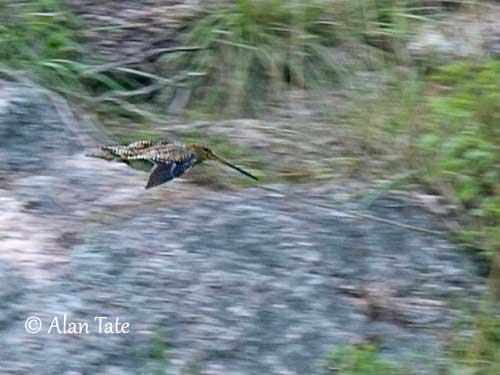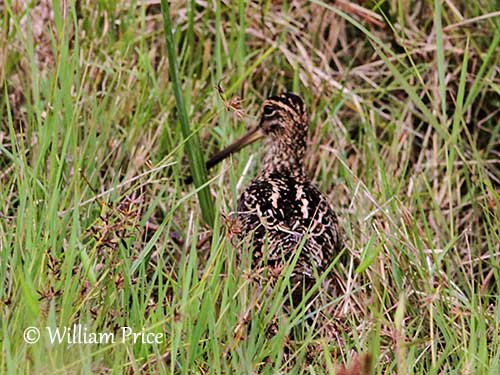
Fr: Bécassine malgache
Ang: Madagascan Snipe
All: Madagaskarbekassine
Esp: Agachadiza Malgache
Ita: Beccaccino del Madagascar
Nd: Madagaskarsnip
Sd: madagaskarbeckasin
Mal: Agoly, Aretaky, Harakaraka, Hotrika, Kekakeka, Kitananata, Ravarava, vano
Photographers:
William Price
PBase-tereksandpiper & Flickr William Price
Dubi Shapiro
Dubi Shapiro Photo Galleries & Dubi Shapiro's Pictures on IBC
Alan & Ann Tate
AA Bird Photography
Text by Nicole Bouglouan
Sources:
HANDBOOK OF THE BIRDS OF THE WORLD Vol 3 by Josep del Hoyo-Andrew Elliott-Jordi Sargatal - Lynx Edicions - ISBN : 8487334202
The Birds of Africa: Volume VIII: The Malagasy Region: Madagascar, Seychelles, Comoros, Mascarenes - Par Roger Safford, Frank Hawkins – ISBN: 1408190494, 9781408190494- Editeur: A&C Black, 2013
Birds of Madagascar and the Indian Ocean Islands Par Roger Safford, Adrian Skerrett, Frank Hawkins – ISBN: 1472924118, 9781472924117- Editeur: Bloomsbury Publishing, 2015
Birds of Madagascar: A Photographic Guide Par Pete Morris, Frank Hawkins – ISBN: 0300077556, 9780300077551- Editeur: Yale University Press, 1998
SHOREBIRDS by Peter Hayman, John Marchant and Tony Prater – Christopher Helm – 1986 – ISBN: 0747014035
Wikipedia, the free encyclopaedia
Madagascan Snipe
Gallinago macrodactyla
Charadriiformes Order – Scolopacidae Family
INTRODUCTION:
The Madagascan Snipe is endemic to Madagascar. This large, heavy, long-billed snipe is usually found in dense vegetation in marshes and swamps and other wet areas. It is mainly found in E Madagascar where it is fairly common in wetlands.
During the breeding season, it performs aerial displays typical of snipes. It feeds on invertebrates and plant matter while walking slowly and probing its long bill into soft soil or mud.
The Madagascan Snipe has small, declining population threatened by conversion of wet habitats to ricefields, and by hunting pressure. The species is listed as Vulnerable.
DESCRIPTION OF THE BIRD:
Biometrics:
Length: 29-32 cm
Weight of one female: 216 g
Bill length: 80-115 mm
The Madagascan Snipe has dark brown upperparts with complex paler brown and buff pattern. There are conspicuous buff lines on mantle and scapulars. On the upperwing, the wing-coverts show olive-brown spots at tip. In flight, we can see an indistinct pale grey wingbar on greater coverts, and a pale grey trailing edge to secondaries. The uppertail-coverts are cinnamon-buff with dark bars. The tail has 16 feathers, the outer with some white and the central rectrices mostly bright cinnamon.

On the underparts, chin and throat are whitish. The breast is buff with brown streaks. Rest of underparts is white with heavy brown barring on flanks. The underwing is fairly dark due to the broad dark barring.
The head is typically patterned with dark brown crown, pale buff central stripe, dark eye stripe and an indistinct dark bar across the cheeks. There is a conspicuous whitish supercilium and the ear-coverts are finely streaked.
The long, straight bill is dark but more blackish towards the tip. The eyes are dark brown. Legs and feet are greenish-grey.
Male and female have similar plumage, but the female has on average 10% longer bill than male. There is no seasonal variation.
The juvenile is similar to adults, but the upperwing-coverts are fringed warm olive-buff.
RANGE:
The Madagascan Snipe is mainly found in C and E Madagascar, from Tsaratanana, S to Mandena and W to R Sakay on Central Plateau.
HABITAT:
The Madagascan Snipe frequents freshwater marshes and swamps with dense vegetation, mainly grasses and sedges, muddy areas such as edges of lakes and streams, flooded fields and ricefields. The species occurs from sea-level up to 2,500/2,700 metres of elevation.
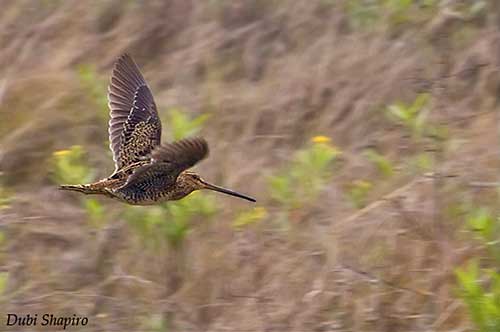
CALLS AND SONGS: SOUNDS BY XENO-CANTO
The Madagascan Snipe gives a series of hoarse, rapidly repeated “checka-eck…eck…eck…eck…eck…” when flushed, with higher and more spaced last notes.
The aerial display fairly similar to that of the Common Snipe is accompanied by a rapid sequence of notes “wikwikwikwikwikwikwikwik…” lasting 2-4 seconds. A deep “woo-woo-woo” that sounds very loud at close range is a mechanical noise produced by the spread tail feathers during the display flight.
BEHAVIOUR IN THE WILD:
The Madagascan Snipe feeds on invertebrates (insects and worms), seeds and other plant matter. It forages by walking slowly and probing its long bill vertically into the soft soil or mud.
It is usually found alone or in pairs, but outside breeding season, it often occurs in groups of 4-8 individuals. They rarely flush in flocks.
When the bird is threatened, it initially freezes, but then, it flushes while giving a hoarse call.
The cryptic plumage allows the bird to stand motionless among the marshy vegetation.
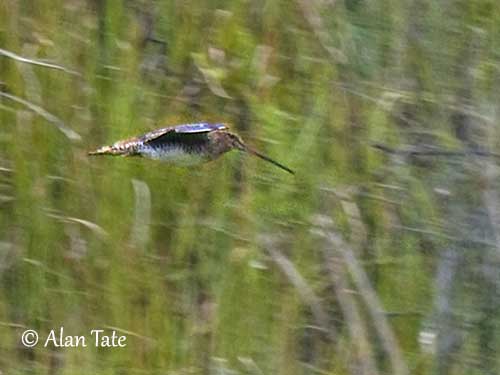
During the breeding season, the Madagascan Snipe performs aerial displays very similar to those of the Common Snipe, but slightly louder due to the larger size of the bird.
It flies high in circles, followed by powerful swoop. During the swoop, the vibrations of the outer tail feathers produce a drumming noise.
The Madagascan Snipe is probably sedentary on the island.
During the flight after being flushed, the bird appears heavy and slow with shallow wingbeats, and with or without twisting. It does not perform the fast zigzags of the Common Snipe and it often lands a short distance away.
REPRODUCTION OF THIS SPECIES:
The laying takes place at least from July to January and may extends to April or maybe year-round.
The Madagascan Snipe forms a depression on dry hummock, with or without lining of dry grass, at about 60 centimetres above water level. It is described as a very slight structure of dry grasses, placed on banks of small marshes where the water cannot reach it.
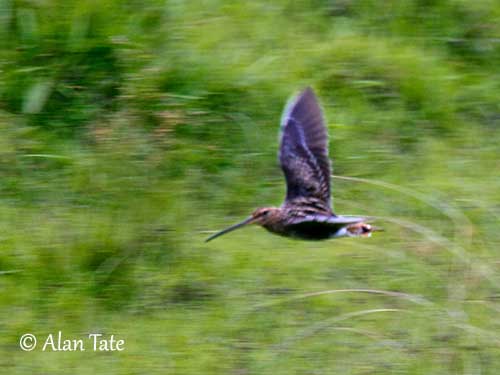
The female lays 1-2 eggs of cryptic colour. The incubation period is unknown. At hatching, the chicks have cryptic plumage with mottled, barred and streaked pattern overall.
The incubating adult may perform distraction display such as broken wing involving inability to fly if it is disturbed or threatened, in order to lead the intruder away from the nest.
The feathered chicks start clambering and running through the grass if they are disturbed while giving “peo-ooo” calls.
PROTECTION / THREATS / STATUS:
The Madagascan Snipe is affected by wetland modifications and hunting pressure. The species occurs in several protected areas, but the main marshland sites are unprotected and highly threatened.
The small population is roughly estimated to number 3,500/15,000 individuals and is suspected to be declining.
The Madagascan Snipe is currently listed as Vulnerable.
